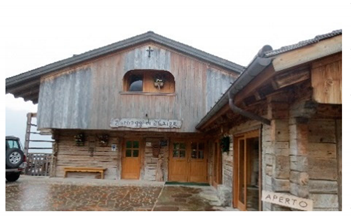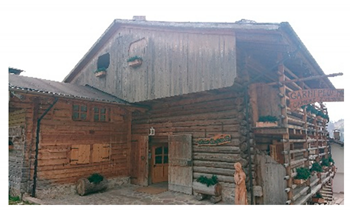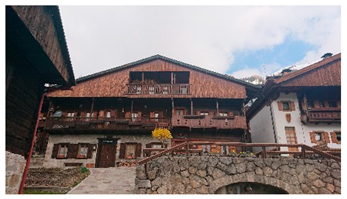Abstract
In the marginal areas of the Alps, there is a huge built heritage expressed by local communities, resulting in an architectural model that is sustainable in terms of its material use, resource exploitation, and landscape coherence. Although buildings in these small settlements have been largely protected from transformation, currently this heritage is largely underused. Thus, it is desirable to consider reuse and enhancement actions that can combine both economic viability and the protection of historic, cultural and architectural values. This paper presents a multi-attribute model for the evaluation of sustainability in reuse projects concerning traditional buildings in the Italian Alpine settlements. For the appraisal of sustainability, the model uses relevant parameters aggregated into three macro-indicators. The model was calibrated by an expert panel and tested on reuse projects in Sauris, in north-eastern Italy, where residential building type is characterized by specific techniques that are expressions of community traditions. The main results show that the attributes aggregation function is predominantly andness in all nodes. A short range in sustainability assessment is a predictable result, as the buildings used for the model’s application give a common judgment in some attributes. Finally, activities for widespread hospitality generate a greater expected return compared to commercial services.
1. Introduction
If the most widespread definition of the concept of sustainability refers to environmental, social, and economic aspects, it follows that the purpose of a requalification intervention, designed to achieve sustainability goals, should be an attempt to increase the quality of life of the community by developing local resources, thus pursuing an objective with a multidimensional nature [1]. The aim of this study is to establish a value function that can summarize the most relevant issues in the choice of intervention options for the reuse of traditional buildings, based on the knowledge of local communities in Alpine cultural region. Integration is required between issues related to economic and social sustainability and the more established issues concerning intervention sustainability at the typological and technical levels. This is a complex process that is not easily measurable with a strictly quantitative approach.
Within this scope, the concept and value of sustainability includes two aspects: first, the sustainability of the renovation of building materials and typology; second, the sustainability of the new function inherent in the reuse, a transformation that can involve consolidation, integration or even a replacement that can change the perception and understanding of the original building. In interventions performed on Alpine architecture, the sustainability target requires a balance between reuse and conservation. In other words, it is necessary to perform a rehabilitation, which is defined as a process that provides the compatible use of a building through repairs, alterations and additions, while preserving functional solutions, features and materials that convey the historical, cultural and architectural values of the community [2]. Moreover, the main cause of the degradation of traditional Alpine buildings and artefacts lies in the absence of a function, leading to their abandonment and ruin, particularly in areas not interested in the considerable exploitation of Alpine tourism, which has occurred in the second half of the last century [3,4,5].
A study conducted in Sauris, north-eastern Italy, which is a small settlement in the Carnic Alps notable for the homogeneous typology found in most of its buildings and artefacts, is suitable for testing a multi-attribute model for assessing the sustainability of reuse. In fact, the preservation of architecture based on functional criteria, such as the use of raw materials available in situ, is strictly linked with the protection of the community that has expressed it through the introduction of new functions compatible with its typological, formal and material features. This approach can contrast heritage loss with the values of which it is the bearer. The European Charter for Architectural Heritage has previously considered the social and economic implications of restoration and recovery: integrated conservation is defined as the integration of built heritage into community life through the introduction of appropriate intended uses, that are capable of respecting the architecture and ensuring its safeguard [6]. The architecture of Sauris offers a built heritage comprising peculiar key elements, requiring congruous protection given the renewed trends in permanent resettlement and the development of more conscious Alpine tourism.
2. Sustainability Evaluation in the Reuse of Mountain Architecture
The vernacular architectural heritage in mountain contexts represents the answer to habitability needs developed by a community in a specific geographic and climatic situation. This is the result of a historical evolution, reflected by the adoption and progressive development of distributive, functional and technological solutions derived from the rational exploitation of the material resources available in situ [7].
The reuse of mountain architecture is an operation with three different targets, which should concur. The first involves the counteraction of the non-use and subsequent ruin of artefacts through the identification of new sustainable uses that are functional for the maintenance and preservation of community values, according to the principles of social and economic sustainability. The second involves the adaptation of functionality and performance to the current standards of safety, reliability and comfort. Finally, the third target is the preservation of historical and cultural values found in the individual artefacts and, from a wider perspective, in the whole community that has conveyed them over time.
In the theoretical framework concerning adaptive reuse and conservation, reuse projects certainly do not fall within the scope of integral conservation [8]. Attributing new functions, the conservation of original construction materials and techniques is often not possible due to necessary consolidation and replacement works. Moreover, the choice for non-use often leads to the loss of an artefact’s intrinsic values, resulting from abandonment and ruin. Incompatible use, similarly, leads to the same loss [9].
The rehabilitation of this heritage, particularly for an intervention that contemplates a new intended use, must comply with the features of mountain architecture: specifically, the use of local materials and the typology of the community housing. This occurs in accordance with the vision of mountain architecture as an application of sustainability principles that involves the exploitation of local resources, coherence in the development of settlements in the landscape, and the evolution of livability solutions that are gradually refined over time.
Traditional buildings in the Friuli historic region evidence a remarkable variety of local architectural typologies that cannot be summarized in the physical boundaries of the artefacts. It requires the investigation of traditional features, technical knowhow and local experience, welded together and deeply blended with the landscapes. Mountain architecture displays the knowledge of its master-builders adapting to a place, respecting the landscape, and addressing the social and cultural identity of territories [10].
In the scope of mountain architecture in the Friuli historic region, this vision is effectively highlighted in the regulations enacted for the management of the seismic events of 1976. Regional Law No. 30/1977 concerns the housing needs in areas affected by earthquakes, establishing the functional and static recovery of existing buildings while considering the protection and preservation of the local architecture. In addition, Regional Law No. 63/1977 regulates the reconstruction process based on the extent of aid granted to the owners of destroyed dwellings. The need to re-functionalize existing buildings is accompanied by the need to acknowledge original materials and construction techniques, combining heritage recovery with the preservation of these features in small settlements [11]. Moreover, different sustainability visions are reflected in the studies concerning the Sauris municipality: initially, we see the cultural specificity of the population of German origin, followed by the methods of settlement arising from the geographical site, which is located at more than 1200 m above sea level and lacked stable communication connections until 1934. On the other hand, most recent studies concern the reconstruction of this architectural heritage according to an approach that respects the artefacts’ features, and leave open the debate on the sustainability of renovation interventions [12,13].
The state of degradation and ruin of some buildings and settlements, together with the extent of the transformation of the original features, imposes limits on the sustainability of reuse interventions, in both the historical-architectural and socio-cultural contexts. On one hand, it is economically unsustainable to encourage the recovery of buildings that are so damaged that they require a replacement of entire parts and systems; on the other hand, the socio-economic limit of sustainability depends on the conditions under which expenditure and the public contribution to preservation is acceptable [14,15]. The inclusion of socio-economic aspects, such as intangible heritage, in sustainability evaluations can allow for the recognition of community values that are to be protected [16].
Defining the attributes that can be used to assess sustainability in reuse interventions is, thus, a multi-attribute problem. In the literature, there are several methods that approach multi-attribute problems, including outclassing methods, such as the ELECTRE family [17,18], interactive approaches, and the multi-attribute value approach (MAVT) [19]. The first, which is of French origin, aims to build a relationship of superiority that represents the preferences established by the decision maker, given the available information. The second is characterized by the alternation of calculation phases and interaction phases. Finally, MAVTs, which are of American inspiration, are based on the value function, and rank the achievement of alternatives by attributing to each a score synthesized by an aggregation operator, given a finite and discrete set of alternative options [20]. The most common aggregation operator is the weighted average function, which consists of the weighted average of the values provided by the attributes. Multi-attribute assessment models are often used for economic assessments in different areas, such as in the assessment of benefits arising from urban or environmental regeneration [21,22,23].
In most complex decision-making problems, owing to the presence of conflicting or synergistic information, there are important interactions between attributes. This means that the combined effect of two criteria is greater or lesser than the sum of the effects of each attribute considered separately; thus, the linearity is lost. However, it is possible to implement multilinear structures for aggregation that are capable of capturing the interactions among criteria. For example, considering the i-th alternative, and assuming the existence of only two criteria with values of c1 and c2, the multi-linear value function can be expressed as follows:
where wi are the weights given to the individual attributes and their combinations.
Sustainability indicators can derive from relative points of view, e.g., from a specific historical, architectural or aesthetic sensibility [9,24,25]. Moreover, the sustainability attributes of the reuse interventions are subject to changes over time, depending on the cultural and economic conditions of the involved community, or even the context in which these conditions are determined. The attributes proposed in this study could be useful in limiting the subjectivity involved in the critical interpretation of an artefact and the reuse intervention to be performed.
3. Methodology for Attribute Definition and Calibration
The model presented in this study concerns the application of MAVT for a sustainable reuse of mountain vernacular buildings and artefacts. Thus, the set of attributes and its organization in a structured framework aspires to the specific characterization of minor settlements’ architecture in Alpine regions. Compared to historical buildings relevant to art and history, the latter expresses a different function for decorative apparatus and finishing works, and, as mentioned above, a sensibility for the use of natural material resources.
3.1. Sustainability Attributes and Key Performance Indicators
The operational phase of this study has thus focused on the definition of attributes, expressed according to appropriate indicators, which allow for an assessment of the sustainability level of alternative reuse projects carried out on the Friuli mountain architecture.
The framework adopts a hierarchical approach, which can be traced to international rating systems that are prevalent at a national level in Italy. The framework consists of synthetic attributes capable of reflecting the features comprising reuse projects, and can describe the sustainability level of the intervention itself. The framework structure is shown in Figure 1, while the attributes considering reuse intervention effects are divided into three evaluation areas. Attributes are grouped by operative scopes and, at the higher level, by evaluation areas; only the first area, at an intermediate level, is sub-divided into categories.
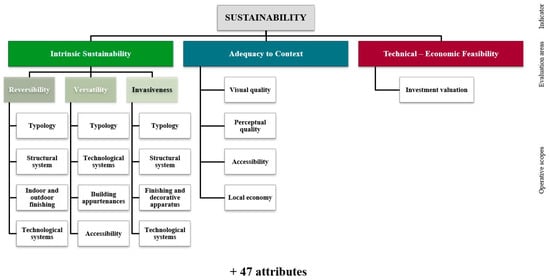
Figure 1.
Structure of the framework for sustainability appraisal of reuse intervention in Alpine mountain architecture.
The Intrinsic Sustainability evaluation area (Table 1) consists of 36 attributes that allow for an assessment of the capability of the intervention as regards the preservation of the building’s architectural and historical features, from the point of view of both the construction techniques and materials used. In turn, the Intrinsic Sustainability area is further divided into three categories to characterize the need for artefact preservation with greater precision. The first category, Reversibility, is intended to reflect the potential for restoring the status quo ante of the building as a result of any additions provided for the reuse; the second, Versatility, refers to the potential for future modifications of the project’s intended use, without resorting to further substantial transformation works; the third, Invasiveness, is an estimation of the degree of interference of the reuse with the building’s material components.

Table 1.
Articulation of the attributes included in the Intrinsic Sustainability evaluation area.
The Adequacy to Context evaluation area (Table 2) consists of seven attributes reflecting the capacity of the reuse project to enhance the environmental, social and economic context and, therefore, evaluating its potential for preserving or enhancing the identity of the local community.

Table 2.
Articulation of the attributes included in the Adequacy to Context evaluation area.
The Technical and Economic Feasibility evaluation area (Table 3) consists of four attributes capable of assessing the reuse project in terms of financial management of the intervention and the subsequent management of the planned activity.

Table 3.
Articulation of attributes included in the Technical and Economic Feasibility evaluation area.
The definition of attributes aims to highlight the role of built heritage rehabilitation in preserving the well-being of the local population, in ensuring an overall economic development capable of attracting qualified human resources; these positive effects can be reached, preserving the authenticity of the territory, through the exploitation of existing cultural assets and considering activities that can be perceived as authentic and coherent with the context both by the local community and tourists [26].
Each attribute is identified by an alphanumeric code that consists of the evaluation area code (IS; AC; TEF), the category code only for Intrinsic Sustainability area (R; V; I), the progressive number for operative scopes and, at the lower level, the number of the attribute.
A value of between 0 and 1 can be assigned to each attribute. This assignment depends on a quantitative approach for 25 of the attributes, identifying within a set of possible scenarios the one that best describes the specific connotation of the reuse project. For each of the remaining 22 attributes, it is possible to define a Key Performance Indicator (hereafter KPI) in the initial model testing step; each KPI expresses synthetically the value of the attribute within a benchmark scale. Identified scales serve to guide the evaluator in the expression of judgments.
The assessment of Intrinsic Sustainability is based on a simplified breakdown of the building; it essentially considers the ability to retain the typological and functional scheme, the reversibility and compatibility of works on load-bearing structures, the finishing or decorative apparatuses, and the appropriateness of the introduction of new technological systems. This assessment is intended to avoid works that may affect the authenticity of material and architectural features. Moreover, the framework analyzes the presence of pre-existing outdoor areas and ancillary spaces that could provide valuable locations for the installation of new technological systems. Table 4 shows the KPIs, thresholds and scenarios used to structure the judgments in Intrinsic Sustainability area attributes.

Table 4.
KPIs and thresholds/scenarios chosen for Intrinsic Sustainability evaluation area.
For the assessment of Intrinsic Sustainability, there are up to three possible choices in the optioneering of each attribute judgment in the IS.R.2 and IS.3 categories. The final judgment derives from the simple average of Reversibility and Invasiveness Indexes, as defined in Formulas (2) and (3), so as to allow one to take into account multiple different intervention types.
The attributes included in the Adequacy to Context assessment allow for an evaluation of the impacts on the surrounding context by determining the degree of compatibility of the intervention with the perception of the building as expressed by the local community, as well as its effects on the circulation and local economy.
Attributes included in Adequacy to Context evaluation area are defined by means of services provided by the new activity, in terms of a function shared with the community, innovation, and integration of the activity into a scenic or cultural path. For private artefacts embedding an activity open to the public, i.e., craftsmanship, the percentage of floor surface deputed to the activity is set as a KPI. Detailed information is provided in Table 5.

Table 5.
KPIs and thresholds/scenarios chosen for Adequacy to Context evaluation area.
Finally, the attributes included in the Technical and Economic Feasibility assessment allow the evaluation of the reuse project based on aspects aimed at verifying the financial autonomy of the intended activity, and the presence of income flows sufficient for making maintenance actions sustainable.
Technical and Economic Feasibility attributes are evaluated via the KPIs to consider different scenarios of the economic activity planned in the reuse project, i.e., private house, hospitality, craftsmanship activity, provision of a new service not originally available in the settlement, or provision of a competitor activity in an already existing service. The definition of possible choices considers on one hand the process that led to the formation of the architectural heritage, involving master-builders and craftsmen; on the other hand, it pursues the generation of appropriate work opportunities and the achievement of sustainable tourism in order to increase the social expectations of the community, embedded in a wide sustainability strategy [27]. The valorization of possible optional Technical and Economic Feasibility attributes is shown in Table 6.

Table 6.
KPIs and thresholds/scenarios chosen for Technical and Economic Feasibility evaluation area.
The attributes concerning the reversibility and invasiveness of works (Intrinsic Sustainability evaluation area, Reversibility and Invasiveness categories) have been treated in such a way as to provide a semi-quantitative evaluation. A documented abacus inherent in the methodologies of interventions into technical elements typical of mountain architecture allows for the definition of a set of specific actions on these elements, in accordance with the simplified breakdown of the building adopted in the definition of the attributes [12,13].
An expert approach allows an appropriate set of parameters capable of expressing the degrees of reversibility and invasiveness of the intervention works to be defined and weighed. For reversibility, with reference to a potential restoration of the status quo ante from the condition of the reuse project, the technical feasibility, damage caused by restoration works, and residual restoration traces are considered as parameters. For the i-th intervention work documented in the abacus, the judgment of reversibility Ri is given by a weighted sum that gives priority to the reversibility of restoration action to the status quo ante:
where fi, di and ti are the part coefficients of technical feasibility, damage caused by restoration, and residual traces, respectively.
For invasiveness, the parameter of damage due to restoration works on technical elements, with reference to the status quo ante, is considered a significant parameter. Thus, for the i-th intervention work, the judgment of invasiveness Ii is given by:
For each attribute included in the IS.R.2 and IS.R.3 operative scopes, it is possible to choose several options, as described in Table 7 for the structural system’s scope. The average of these choices provides the KPI for the Intrinsic Sustainability evaluation area, the Reversibility and Invasiveness categories, and scopes concerning the structural system, finishing and decorative apparatuses. All parameters are defined on a threshold scale according to a quantitative judgment, as per Table 8 [28]. The abaci for the intervention methods are composed according to the information available in the literature for the recovery and restoration of existing valuable buildings, identifying the most relevant construction techniques, and intervention criteria for the reuse of mountain architecture [29,30,31].

Table 7.
Semi-quantitative evaluation of attributes concerning reversibility and invasiveness; assumed numeric judgments are reported for each intervention work.

Table 8.
Parameters for judgments in Reversibility and Invasiveness categories [28].
The KPIs for judgments on the reversibility of interventions affecting the typological scheme are based on threshold evaluation of the new volume added, or the existing volume demolished, compared to the original building volume; the versatility evaluation of the typological scheme is based on such KPIs as the net indoor height, distance between load-bearing vertical structures, and width and slope of stairs. The evaluation of building site accessibility depends on the width and pendency of vehicular access, distance from public transportation access points, service frequency, and availability of parking areas. For weak users, we distinguish non-accessible buildings, buildings with only common and public spaces that are accessible, adaptable buildings, and fully accessible buildings, with a progressively increasing judgment for each scenario. The judgments concerning the installation of new technical plants consider the plant loss factor, intended to reflect the volume dedicated to the placement of plants and facilities compared to the building gross volume. Finally, visible terminals of electric and heating plants are penalized in the visual impact evaluation, because in the original vernacular buildings only a fireplace was present as the precursor to a modern heating system.
The definition of the framework for the sustainability assessment in reuse interventions has been based on the objectivity and repeatability of the evaluation of each attribute, and on the compliance of the attributes with the architectural object being evaluated. In particular, the definition of attributes evaluable by scenarios, as an alternative to the widespread use of KPIs, overcomes the risk of a different judgment being given to the same attribute by different evaluators working in the same scope.
3.2. Framework Weighting Procedure
Once the structure of the assessment framework has been described, each evaluation area, category and attribute are given a weight that defines their contribution in terms of sustainability. Attribute weights are estimated according to a hybrid procedure that implements the edges and the Simos methods [32], as revised by Figueira and Roy [33], and is finally applied through a simplified process proposed for the scope of multicriteria evaluations [34].
The first step is to configure the scenarios characterized by the combination of very bad and very good evaluations. The decision maker orders the scenarios and calculates the non-normalized weights as follows:
- The scenarios are ordered from the least to most important, including ex-aequo, defining the r positions and cr scenarios in the r-th position.
- Blank cards are inserted.
- Values (vr) are assigned based on the positions of scenarios.
- Positions containing blank cards are deleted. In this way, the value assigned to each position, vr, represents an initial non-normalized judgment of the relative importance of each scenario.
- The importance ratio, z, between the least and most important scenarios is defined.
- The weight, pzr, is calculated through linear interpolation to obtain a ratio between the weights associated with the most and least important scenarios, z.
- All weights pzr are scaled from 0 to 100 and normalized to achieve wr, taking into account the interactions between the scenario parameters.
Three scenario levels are distinguished, including first-order scenarios,
second-order scenarios,
and third-order scenarios,
The procedure can easily be extended to higher orders depending on the number of areas, categories and attributes involved.
While the decision maker assigns a rating [0;1] to each attribute, which is then multiplied by its weight, an aggregation operator is calculated at each single node. The synthetic sustainability indicator, V, is formulated as follows:
where ci are attributes in first-order scenarios, categories in second-order scenarios, and evaluation areas in third-order ones; and wi are the weights applied for each scenario.
Moreover, the model provides indices capable of assessing the degree of conservativeness of the value function at each node. These orness, O, and andness, A, indices vary between 0 and 1, and are defined as follows:
where n represents the number of attributes, categories, or areas depending on the hierarchical order at which O and A are evaluated; t is the hierarchical order; and w is the expression for the weights.
In Table 9 and Table 10, an excerpt of the weighting process is reported. The example considers the Reversibility category, as a third-level set of operational scopes, and the Intrinsic Sustainability area as a second-level set of categories. The highlighted sets are characterized by a different number of inputs, and consequently more combinations must be considered according to the edges method.

Table 9.
Scenarios weighting in Intrinsic Sustainability second level area. The attribution of each value judgment, VJ, depends on the valorization of the applicable KPI.

Table 10.
Scenarios weighting in Reversibility third level category.
A total andness measure (O = 0; A = 1) means that at least one attribute is high enough to result in a high aggregate rating, regardless of the value of the other attributes; in the case of a total orness measure (O = 1; A = 0), all attributes must be high in order to produce a high rating. Finally, a simple additive measure means that the rating is given by the sum of the scores assigned to KPI, without considering any synergy among them (O = 0.5; A = 0.5).
In this way, it is possible to consider and mediate different approaches to reuse projects for mountain architecture. The sorting of scenarios, carried out according to the Simos method, can vary depending on the cultural training of the expert performing the valuation. It is therefore possible to treat this different sensibility through a composition of scenarios determined by an expert panel. In the beginning, each expert expresses a value order that defines a weight vector, through the Simos method; subsequently, the average weights obtained by each expert evaluation allows for a determination of the andness and orness indices inherent to the degree of conservativeness. As shown in Figure 2, a variation in the O index modifies the value of the sustainability indicator, V, while retaining the same judgments expressed for the attributes.
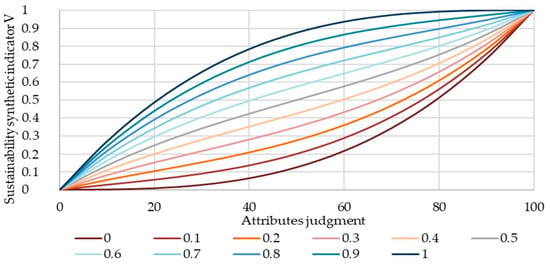
Figure 2.
Variation in the sustainability indicator, V (in ordinates), for curves corresponding to different O index values; the values given to the attributes are shown on the abscissae.
4. Case Study for Model Application
The vernacular architecture considered in this study is widespread throughout the Sauris Municipality in the historic region of Carnia in Friuli–Venezia Giulia. The municipality consists of three main settlements: Sauris di Sotto (seat of the town hall), Sauris di Sopra and Lateis (Figure 3).

Figure 3.
Location of Sauris and general view of the settlements.
In Sauris architecture, the careful use of local natural resources can be observed, in which the building material supply satisfies the control criteria of rationality and availability; in this way, construction techniques seek optimal performance in association with a minimum consumption of virgin materials, such as wood and stone, although these are of large availability. Moreover, a remarkable value of this architecture lies in its sustainable exploitation of territory, as settlements occur in the most suitable location depending on sunlight and shelter from cold winter winds.
These conditions have led to the progressive development of a homogeneous building type that characterizes the buildings in terms of the distribution of functional spaces and common construction techniques. The matrix type of Alpine wooden house has a rectangular plan delimited by load-bearing walls built using the blockbau technique, in which squared overlapping trunks are carved and interlocked at the corners.
The evolution of Sauris houses shows a diversification in looks through an evolution, leading to the distinction of living and bedroom areas through a distribution atrium accessible from the main front (Figure 4). Thus, the factors that characterize this residential type are the position of the entrance, the orientation of the roof pitches relative to the North–South direction, and the relationship of the built volume to the variable land slope. The ground floor, partially underground, is built in river-stone and pebbles, keeping the first floor above the maximum winter blanket [7].
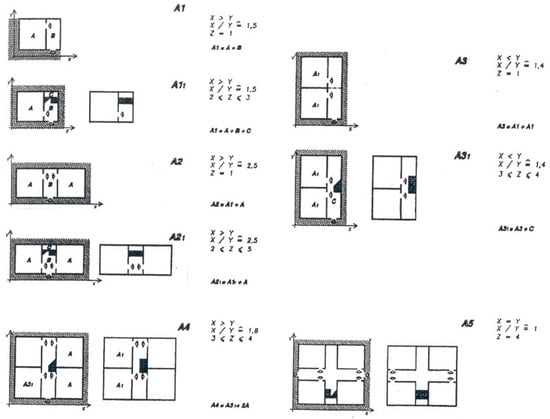
Figure 4.
Building types in Sauris territory. The abacus shows the main activity spaces (A) and distribution spaces (B), combined in a single story in types A1, A2 and A3, and in two stories in the remaining types. Types A2 and A3 represent a single module house, while A4 and A5 represent a double module house [13].
On the ground floor, living rooms are located on the southern front, at a lower height than the north-facing front. In plots where the ground has a significant slope, a transversal position of the distribution atrium is preferred, with consequent double access to the house from opposite sides.
Bedrooms are usually located on the first floor, characterized by the use of the blockbau wooden technique; access is granted by internal stairs, and the access extends to the balcony as well (Figure 5).
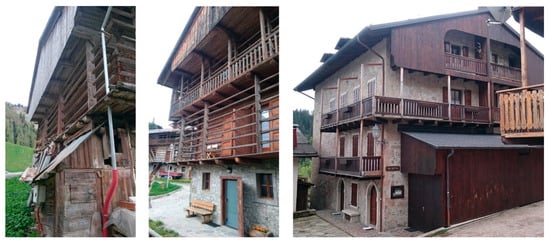
Figure 5.
Examples of different load-bearing structural systems in Sauris di Sopra settlement—image taken by the authors.
The transformation of Sauris residential types has also involved technical elements, which are the result of a continuous evolution from entirely wooden construction to mixed construction with wood and river-stone; the most recent buildings are constructed entirely of hydraulically bound stone. Sauris’ vernacular architecture covers the range of specific housing answers developed by the local community, evolving from a matrix-type through continuous revisions and improvements.
The proposed multi-attribute model was tested on four Sauris buildings. A brief description of each building is provided in Table 11, Table 12, Table 13 and Table 14; for case No. 1, the evaluation was carried out ex-ante on the reuse project documents, while the remaining cases were analyzed based on the reuse interventions already performed.

Table 11.
Description of case study No. 1 for multi-attribute model application—image taken by the authors.

Table 12.
Description of case study No. 2—image taken by the authors.

Table 13.
Description of case study No. 3—image taken by the authors.

Table 14.
Description of case study No. 4—image taken by the authors.
5. Results and Discussion
As stated above, the andness and orness indices used in the model are derived through an expert approach (Figure 6). First, the results show that the aggregation function of attribute judgments, after mediation based on expert-based indications, is predominantly andness in all aggregation nodes. As an example, for a theoretical intervention in which a value 0.5 is given to all attributes, the aggregation function provides a sustainability indicator of V = 0.363 (Figure 7, Figure 8, Figure 9 and Figure 10). This means that on one hand, a reuse project can be said to be sustainable when several categories and attributes receive a high judgment. However, on the other hand, that reuse project must not only be respectful of the features of which Sauris vernacular architecture is the bearer, but also must be economically sustainable, with particular attention paid to its relationship with the local context.
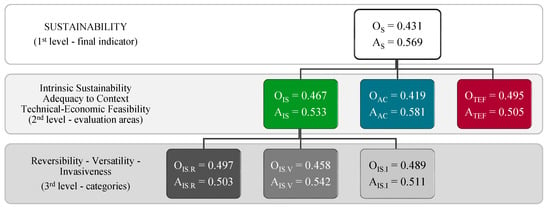
Figure 6.
Andness and Orness indices at the different nodes of the evaluation, obtained according to the Simos method as revised by Figueira and Roy [33].
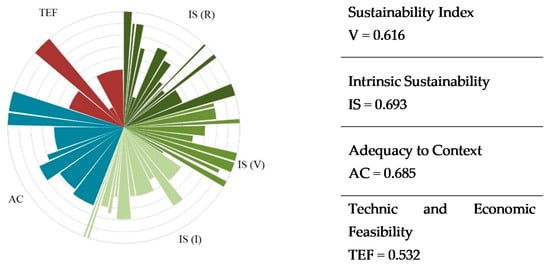
Figure 7.
Attribute judgment and aggregated indicators for case study No. 1.
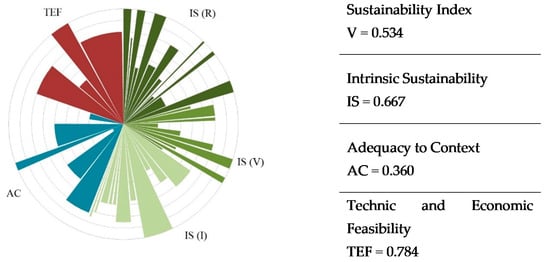
Figure 8.
Attribute judgment and aggregated indicators for case study No. 2.
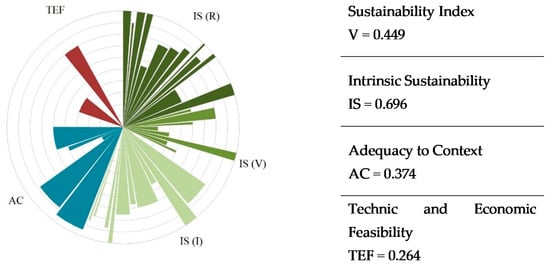
Figure 9.
Attribute judgment and aggregated indicators for case study No. 3.
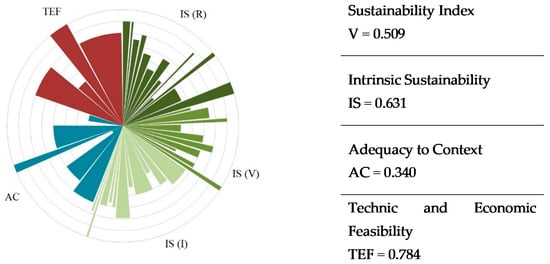
Figure 10.
Attribute judgment and aggregated indicators for case study No. 4.
The overall sustainability assessment for each case study considered fluctuates in the range of 0.449–0.616, which is a predictable result as the buildings subjected to these reuse projects are in the same context and, therefore, will have a common judgment in some attributes.
In this regard, the attribute of Accessibility to public transportation (Intrinsic Sustainability area, Versatility category, Accessibility scope, attribute 2) is used as an example. In considering the distance between the study building and the public transportation access point, the value is penalized in all cases by the low frequency of the public transportation service, giving a judgment varying between 0.22 and 0.26. In addition, the methodologies adopted for the retrofit of structures and architectural envelopes have a limited set of possible actions, thus generating a short list of judgments that can be attributed.
The assessment of individual reuse projects provides results that are generally sufficient, giving a simple average of attribute judgments that is greater than 0.6 in all case studies. Case No. 3 is penalized for a low performance in the Technical and Economic Feasibility evaluation area, as the intervention is aimed at restoring the function of a private house, with modest effects on the economic profile and potential activity sharing by the community. All of the reuse interventions exhibit good performances in terms of the intrinsic sustainability, which is aimed at the conservation of the geometric and material aspects of the buildings. It should be noted that the proposed interventions must comply with the requirements of the Typological Standards of the Municipality General Development Plan.
The highest ratings in the Technical and Economic Feasibility evaluation area are achieved for activities of widespread hospitality, such as Albergo Diffuso and Bed and Breakfast, as these are capable of generating a greater than expected return compared to commercial services or dwellings, while being embedded in a service typology already present in the Sauris community.
6. Conclusions
The multi-attribute model proposed in this paper aims to define an organized set of attributes capable of evaluating the sustainability of reuse projects for mountain architecture, specifically the vernacular architecture of mountain settlements in the Friuli historic region in north-eastern Italy. The proposed model has been tested in the context of Sauris, which is characterized by building types that trace the historical evolution of the settlements.
With respect to experience obtained from the literature, the attributes were organized in a hierarchical framework and further calibrated to capture the needs connoting the reuse of these specific buildings.
Considering the remarkable homogeneity that characterizes the settled portion of Alpine territory in terms of architectural expression, material culture and landscape organization, the model’s construction allows for future development of the research, i.e., by applying the model to other mountain contexts. In this way, it could be possible to overcome current limitations, such as the evaluation of several attributes by qualitative scenarios. Moreover, the study of a context different in terms of construction materials and techniques can lead to a more objective classification of actions performable in building refurbishment in terms of technical feasibility, induced damage and residual traces.
Thus, a future objective is the implementation of scenario evaluations, with a desired improvement in the specifications comprising the Reversibility and Invasiveness abaci, and a strengthening of the weighting system through an updating of the requirements for the protection and reuse of mountain cultural heritage.
The synthesis of such complex assessments in a single sustainability indicator does not catch all the peculiarities of the various projects assessed. The use of a model based on synthetic numerical judgments also entailed the need to set the judgment of some qualitative attributes according to scenario evaluation, leading to the possibility that no scenario among those proposed is able to describe the qualities of the evaluated alternative.
The semiquantitative approach at the basis of the judgments in the Reversibility and Invasiveness abaci allows one to update and—where appropriate—correct the model. The description of scenarios related to technical feasibility, damages and residual traces, according to qualitative, clear parameters as per Table 7 and Table 8, can broaden the set of intervention works related to reuse projects, and help in appropriately considering the technological developments made in the field of building refurbishment.
Author Contributions
Conceptualization, P.R. and P.M.; methodology, P.R., R.B. and C.A.S.; validation, P.R. and P.M.; formal analysis, C.A.S. and P.R.; investigation, C.A.S. and R.B.; data curation, C.A.S. and. R.B.; writing—original draft preparation, C.A.S. and R.B.; writing—review and editing, C.A.S.; visualization, C.A.S. and R.B.; supervision, P.R. and P.M. All authors have read and agreed to the published version of the manuscript.
Funding
This research received no external funding.
Conflicts of Interest
The authors declare no conflict of interest.
References
- Howarth, R. Defining sustainability: An overview. Land Econ. 1997, 73, 445–447. [Google Scholar]
- Mazzarella, L. Energy retrofit of historic and existing buildings. The legislative and regulatory point of view. Energy Build. 2015, 95, 23–31. [Google Scholar] [CrossRef]
- Nijkamp, P.; Voogd, H. Conservazione e Sviluppo: La Valutazione Nella Pianificazione Fisica; Franco Angeli: Milano, Italy, 1990; ISBN 978-88-204-3573-8. [Google Scholar]
- Bottero, M.; Dell’Anna, F.; Nappo, M. Evaluating Tangible and Intangible Aspects of Cultural Heritage: An Application of the PROMETHEE Method for the Reuse Project of the Ceva–Ormea Railway. In Integrated Evaluation for the Management of Contemporary Cities; Mondini, G., Fattinnanzi, E., Oppio, A., Bottero, M., Stanghellini, S., Eds.; Springer: Cham, Switzerland, 2018; pp. 285–295. [Google Scholar]
- Dell’Ovo, M.; Bassani, S.; Stefanina, G.; Oppio, A. Memories at risk. How to support decisions about abandoned industrial heritage regeneration. Valori Valutazioni 2020, 24, 107–115. [Google Scholar]
- Council of Europe. The Declaration of Amsterdam; Directorate of Press and Information: Strasbourg, France, 1975. [Google Scholar]
- Tronconi, O. L’architettura Montana; Maggioli Editore: Santarcangelo di Romagna, Italy, 2014; ISBN 978-88-387-6299-4. [Google Scholar]
- De Angelis d’Ossat, G.; Pane, R.; Di Stefano, R. Il restauro in Italia e la Carta di Venezia. Restauro 1977, 33, 105–107. [Google Scholar]
- Dallavalle, M.; Giove, S.; Rosato, P.; Zanatta, V. La Valutazione Della “Sostenibilità” dei Progetti di Riuso Delle Dimore Storiche. In Villas, Stately Homes and Castles: Compatible Use, Valorisation and Creative Management. Evaluation Criteria and Pilot Projects; Edizioni Lunargento: Venezia, Italy, 2006; pp. 73–99. ISBN 88-900974-5-0. [Google Scholar]
- Guillaud, H. Socio-Cultural Sustainability in Vernacular Architecture. In Versus, Heritage for Tomorrow: Vernacular Knowledge for Sustainable Architecture; Correia, M., Dipasquale, L., Mecca, S., Eds.; DIDA Dipartimento di Architettura Università degli Studi di Firenze: Firenze, Italy, 2015; pp. 49–55. [Google Scholar]
- Croatto, G.; Turrini, U.; Bertolazzi, A. Friuli, 6th May 1976. Retrieving architectural memories as landmarks. Valori Valutazioni 2016, 17, 29–37. [Google Scholar]
- Stival, C.A.; Croatto, G.; Valcovich, E. Sauris residential building type. Analysis of typologic and constructive characters for a coherent rehabilitation intervention. TEMA 2017, 3, 12–23. [Google Scholar]
- Gentilli, R.; Croatto, G. Il Patrimonio Salvato; Forum Edizioni: Udine, Italy, 2008; ISBN 978-88-842-0484-4. [Google Scholar]
- Nesticò, A.; Morano, P.; Sica, F. A model to support the public administration decisions for the investments selection on historic buildings. J. Cult. Herit. 2018, 33, 201–207. [Google Scholar] [CrossRef]
- Piantadosi, E. Rural Architecture and Cultural Identity; Forum Edizioni: Udine, Italy, 2007. [Google Scholar]
- Ferretti, V.; Comino, E. An integrated framework to assess complex cultural and natural heritage systems with Multi-Attribute Value Theory. J. Cult. Herit. 2015, 16, 688–697. [Google Scholar] [CrossRef]
- Roy, B. The Outranking Approach and the Foundations of ELECTRE Methods. In Readings in Multiple Criteria Decision Aid; Bana e Costa, C.A., Ed.; Springer: Berlin/Heidelberg, Germany, 1990; pp. 155–183. [Google Scholar]
- Roy, B.; Bouyssou, D. Aide Multicritère: Méthodes et Cas; London School of Economics and Political Science: Paris, France; London, UK, 1993; ISBN 2-7178-2473-1. [Google Scholar]
- Vincke, P. Analysis of multicriteria decision aid in Europe. Eur. J. Oper. Res. 1986, 25, 160–168. [Google Scholar] [CrossRef]
- Ferretti, V.; Bottero, M.; Mondini, G. Decision making and cultural heritage: An application of the Multi-Attribute Value Theory for the reuse of historical buildings. J. Cult. Herit. 2014, 15, 644–655. [Google Scholar] [CrossRef]
- Rosato, P.; Breil, M.; Giupponi, C.; Berto, R. Assessing the impact of urban improvement on housing values: A hedonic pricing and multi-attribute analysis model for the historic centre of venice. Buildings 2017, 7, 112. [Google Scholar] [CrossRef]
- Berto, R.; Stival, C.A.; Rosato, P. The Valuation of Public and Private Benefits of Green Roof Retrofit in Different Climate Conditions. In Values and Functions for Future Cities; Mondini, G., Oppio, A., Stanghellini, S., Bottero, M., Abastante, F., Eds.; Springer: Cham, Switzerland, 2019; pp. 145–166. [Google Scholar]
- Bottero, M.C.; Dell’Anna, F.; Gobbo, G.L. A PROMETHEE-based approach for designing the reuse of an abandoned railway in the Monferrato Region, Italy. Int. J. Multicriteria Decis. Mak. 2019, 8, 60–83. [Google Scholar] [CrossRef]
- Rosato, P.; Alberini, A.; Zanatta, V.; Breil, M. Redeveloping derelict and underused historic city areas: Evidence from a survey of real estate developers. J. Environ. Plan. Manag. 2010, 53, 257–281. [Google Scholar] [CrossRef]
- Giove, S.; Rosato, P.; Breil, M. An application of multicriteria decision making to built heritage. The redevelopment of venice arsenale. J. Multi-Criteria Decis. Anal. 2011, 17, 85–99. [Google Scholar] [CrossRef]
- Lazzeroni, M.; Bellini, N.; Cortesi, G.; Loffredo, A. The territorial approach to cultural economy: New opportunities for the development of small towns. Eur. Plan. Stud. 2013, 21, 452–472. [Google Scholar] [CrossRef]
- Pulido-Fernández, J.I.; Cárdenas-García, P.J.; Espinosa-Pulido, J.A. Does environmental sustainability contribute to tourism growth? An analysis at the country level. J. Clean. Prod. 2019, 213, 309–319. [Google Scholar] [CrossRef]
- Franchini, F.; Turrini, U. Parametri di Reversibilità Nel Recupero Architettonico e Strutturale; Edizioni Libreria Progetto: Padova, Italy, 2012; ISBN 9788896477366. [Google Scholar]
- Grecchi, M.; Malighetti, L.E. Ripensare il Costruito. Il Progetto di Recupero e Rifunzionalizzazione Degli Edifici; Maggioli Editore: Santarcangelo di Romagna, Italy, 2008; ISBN 9788838747250. [Google Scholar]
- Zerbinatti, M.; Scarzella, P. Recupero e Conservazione Dell’edilizia Storica.; Alinea Editrice: Firenze, Italy, 2009; ISBN 9788860553737. [Google Scholar]
- Astrua, F.; Nelva, R. Manuale del Recupero Edilizio; Maggioli Editore: Santarcangelo di Romagna, Italy, 2017; ISBN 9788891616043. [Google Scholar]
- Simos, J. Evaluer L’impact Sur L’environnement: Une Approche Originale par L’analyse Multicritère et la Négociation; Presses Polytechniques et Universitaires Romandes: Lausanne, Switzerland, 1990. [Google Scholar]
- Figueira, J.; Roy, B. Determining the weights of criteria in the ELECTRE type methods with a revised Simos’ procedure. Eur. J. Oper. Res. 2002, 139, 317–326. [Google Scholar] [CrossRef]
- Crisman, B.; Martellos, L.; Rosato, P. Evaluating investments to improve the safety of urban provincial roads: A hierarchical multi-attribute approach. Valori Valutazioni 2018, 20, 41–56. [Google Scholar]
© 2020 by the authors. Licensee MDPI, Basel, Switzerland. This article is an open access article distributed under the terms and conditions of the Creative Commons Attribution (CC BY) license (http://creativecommons.org/licenses/by/4.0/).
